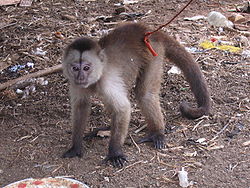| Chestnut capuchin | |
|---|---|
 | |
| In French Guiana | |
| Scientific classification | |
| Domain: | Eukaryota |
| Kingdom: | Animalia |
| Phylum: | Chordata |
| Class: | Mammalia |
| Order: | Primates |
| Suborder: | Haplorhini |
| Infraorder: | Simiiformes |
| Family: | Cebidae |
| Genus: | Cebus |
| Species: | C. castaneus |
| Binomial name | |
| Cebus castaneus I. Geoffroy, 1851 | |
The chestnut capuchin or chestnut weeper capuchin (Cebus castaneus) is a species of capuchin monkey from northeastern Brazil, southern Guyana, Suriname, and French Guiana. [2]
